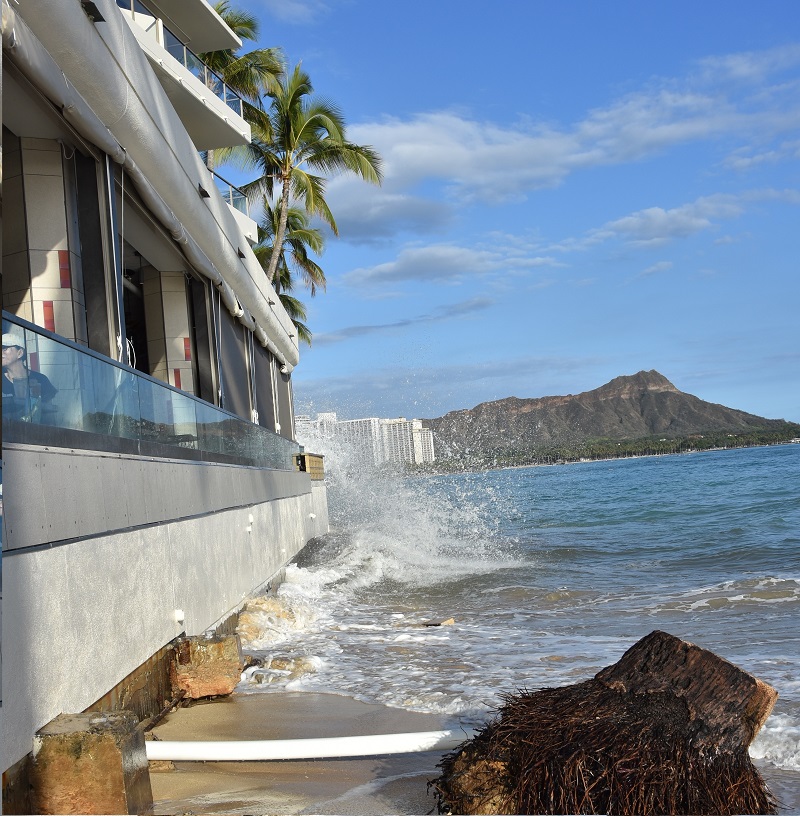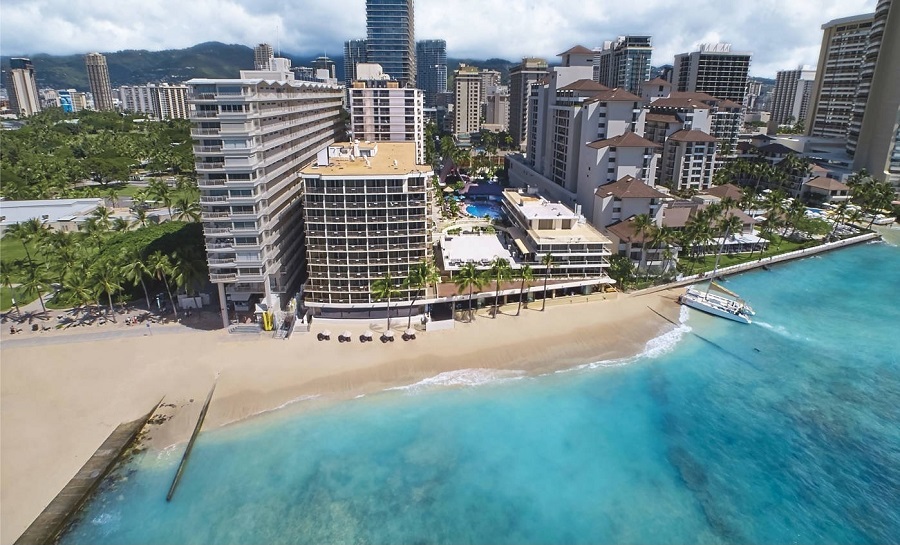KSL Capital Partners’ Outrigger Reef Waikiki Beach Resort asset may be exposed to sea level rise risk. Will the hotel be underwater in the future? Waikiki stakeholders should act now.
In this report we look at the Outrigger Reef Waikiki Beach Resort as a highly visible case study on the risks to Waikiki’s infrastructure from sea level rise.
The Outrigger Reef Waikiki Beach Resort is one of Outrigger’s high-value assets. It is a Waikiki beachfront hotel owned in fee-simple by Outrigger. Outrigger Hotels Hawaii is owned by the private equity firm, KSL Capital Partners.
In this report we look at the following:
- What the building and beach looked like in the past compared to today.
- Trends in public policy to manage sea level rise and shoreline setbacks.
- Statements by Outrigger and a sea level rise expert in response to proposed county policy.
- What stakeholders should do now to respond to sea level rise impacts to Waikiki assets.
What It Looks Like Now
The Reef’s underground parking garage appears to lie below ground level. Photos show that sea water reaches the building during high tides.
Ocean waves crash into the Outrigger Reef as guests dine at the hotel restaurant. Exposed concrete, pipes, rusted metal and dead palm tree stumps can be seen in the foreground. The famous Diamond Head monument is in the background. Photo taken 5/8/24.
Waves crash into the wall of the hotel. Dead palm tree stumps can be seen. Photo taken 5/8/24.
Beachgoers enjoy the beach at low tide. The dead palm tree stumps were removed. Photo taken 7/27/24.
What It Looked Like Then
This undated marketing photo from the Outrigger.com website shows a wide sandy beach with live palm trees. Retrieved from Outrigger.com 7/18/24.
A Google Maps screenshot dated 2015 gives a reference point to how the beach behind the Reef has changed in nine years.
Trends In Public Policy
The sea level rise threat to Waikiki properties is urgent. In 2023, a member of the Honolulu City Council proposed Resolution 23-207 which would require regular inspection of beachfront hotels by licensed professionals. The City Council chairman warned:
“Sea level rise isn’t a distant threat; it’s happening now, and we must take tangible steps to ensure that potentially impacted areas like Waikiki remain safe and thriving.”
Outrigger opposed the inspection policy. Outrigger CEO Jeff Wagoner dismissed the resolution as unnecessary, arguing it would duplicate existing practices by hotels. Outrigger’s Chief Commercial Officer Sean Dee argued that the government should focus on the degradation of beaches around Outrigger properties and leave inspection and maintenance to the hotel owners (Some Waikiki stakeholders focus on the idea of beach sand replenishment, but that does not provide a long-term solution if the sand ends up below the waterline at high tides, nor does it address the underground water inundation problem).
Dr. Chip Fletcher, a respected geologist and climate scientist at the University of Hawaii, warned that groundwater inundation is a threat to Waikiki hotels, stating,
“In fact, the water table under Waikiki actually goes up and down with tides because it is directly connected to the ocean,” he said. “And that salt water in the ground is flooding into the basements of buildings all across Waikiki, even as we speak, with every high tide; it’s a very common problem, and it threatens the integrity of the foundations of these buildings.”
Furthermore, Honolulu has development rules based on shoreline setbacks. In 2023, Honolulu passed two bills increasing the shoreline setback rules for new buildings. Starting in July 2024, the setback will increase from 40 feet to between 60 to 130 feet measured from the high-water mark, depending on the coastal erosion rate and location and size of the development.
As sea levels rise and erosion becomes more pronounced, there is no predicting how lawmakers may amend rules governing maintenance and re-development of hotel properties that fall within shoreline setbacks.
What Stakeholders Should Do Now
In 2019, Outrigger began an $80 million renovation project at the Reef that ended in 2022. A Google Maps screenshot dated 2019 shows the Reef hotel had a spiral walkway going directly from the lobby into the hotel’s underground parking garage. Between the 2019 photo and today, the walkway ramp was removed; the lobby floor is now flat where the spiral walkway used to be.
A Google Maps screenshot dated 2019 shows a spiral pedestrian walkway providing access from the hotel lobby into the underground parking garage. As of 2024, that walkway no longer exists.
The walkway from the lobby into the garage was covered over. Photo taken June 2024.
Potential buyers, insurers or lenders should ask how much, if any, of the $80 million renovation project was spent on sea level rise mitigation measures. Stakeholders should ask why that access path to the underground garage was removed. The Reef only offers valet parking now and restricts access to the underground garage to parking valets.
Stakeholders should ask about the state of the underground parking garage.
The questions raised here could be extended to the risk exposure of Waikiki hotels in general; a serious concern for Hawaii tourism stakeholders.
UNITE HERE Local 5 is committed to fighting for the long-term sustainability of tourism in Hawaii. As sea level rise and global warming impacts begin to manifest in Hawaii, we will fight to make sure tourism benefits local workers and their families.









